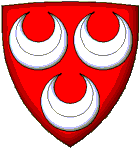William, ninth Lord Oliphant, third son of the sixth Lord. His first appearance in record is in 1681, when he obtainted a commission as captain in a Scots regiment raised by Colonel Henry Gage for the Spanish service in Flanders; his name occurs in a pay-list of that regiment in February 1683, being then, and up to 29 April 1684 at least, in garrison at Mons in Hainault. The reigiment was probably disbanded soon afer wards, for in the following year he and two others, 'all good men having held commissions abroad' were sent to assist the Marquis of Atholl in suppressing the Argyll rebellion. On 7 November 1685 he was appointed captain of a new company of foot to be added to the Scots Guards, in which regiment he remained till October 1687, and probably later. On 20 May 1686 the Privy Council recommended General Drummond to grant him 'forloff' to go abroad about his necessary affairs for two months, which suggests that he as already married when he left the Spanish service. Before or shortly after the Revolution he went to Ireland, whench he retured to Scotland to take part in the Killiecrankie campaign as lieutenant-colonel in the regiment of his cousin Lewis, Viscount Frendraught. He subscribed the Band of Tomintoul 15 January 1690. After the break up of the Jacobite army at Haughs of Cromdale, he remained with the force which under Buchan and Cannon kept the field in Aberdeenshire, and in September 1690 made a raid to within a few miles of Stirling. On the 28 of that month he with Frendraught and a few others took possession of the castle of Federate in Buchan, which they held against Mackay for three or four weeks. After the capitulation of this, the last stronghold held for King James of he mainland of Scotland, he was kept a prisoner at Perth till, on 12 November 1691 the Privy Council ordered his release; on 26 January 1692 he was allowed to go to London to solicit King William's permission to rejoin his wife and family in Flanders, whom he had not seen for three years. His name is in the list of Jacobite exiles charger with fighting against their countrymen in the campaigns of 1692 and 1693. From this time a letter dated at Rotterdam on 20 April 1695, and his signature as witness to a deed at Pittendreich on 14 January 1702, are all we hear of him till 1710, when he is found settled at Orleans with his wife. In the register of his daughter's marriage in that year he is styled 'lieutenant-colonel des gardes du corps de sa Majeste Britannique,' which disproves the statement that he served in the French Army. Next year he returned to Scotland by way of Rotterdam, where he borrowed money at Christmas 1711; and he remained in Scotland till the '15, in which he took part, though his services to the cause are somewhat slightingly spoken of by Mar and Lewis Innes. After the collapse of the rising he remained in hiding among his Perthshire friends, and was still, it seems there 16 August 1716, but shortly thereafter succeeded in escaping to France. There is a letter from Mar to him among the Stuart Papers, dated 11 September 1716, refusing a request for a new commission as brigadier; and a letter of 28 of that month, addressed to him at Orleans, has been printed. Since the battle of La Hogue in 1692, he had been one of the Jacobite officers 'subsisted' first as lieutenant-colonel and afterwards as full colonel; and he was still on the list in 1717. After May 1719 he obtained a pension, which he retained till his death. Succeeding his nephew in the title, though not in the effective possession thereof, in January 1721, he finally left France in January 1722, and after a stay of some weeks in London came back to Scotland, where he remained, the guest of James Oliphant of Gask at the house of Williamston, till his deat, 27 December 1728.
He married, probably while in the Spanish service, Marie Magdeleine Elinga, a lady of Frisian estraction, but described in the family papers as daughter of a councillor of Ghent. The name does not occur in the list of councillors at the period; but she may well have been daughter or sister of Pieter Emmanuel Elinga, who between 1690 and 1700 is styled 'lord of Zuydelynde, first bailiff of his Majesty's waters and fisheries of the Province of Flanders,' and in all likelihood she was the widow of Louis Francois de l'Eglise, captain in the regiment of the Sieur de Fay, to whom a lady of the name was married 10 March 1680, and who died before 11 June 1681, the date of the commission of his successor. By her Lord Oliphant had, besides apparantly a son or sons who predeceased him, a daughter: -
1) Marie Jeanne (or Marie Jean-Baptiste), who was married at Orleans, 19 November 1710, to Louis Grenolias sieur de Cournou, 'commissaire provincial de l'artillerie de France'; on which the Duke of Perth wrote a letter of congratulation to her father. Of this marriage there were three sons and two daughters, born between 1712 and 1717, some of whom seem to have been alive in 1736, when they are alluded to as the ninth Lord's 'grandchildren at Orleans'; but of their descendants nothing is known, and the surname Grenolias does not occur among the existing French noblesse.
William, Lord Oliphant, had also a natural daughter, married in Banff. |







